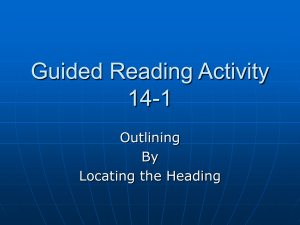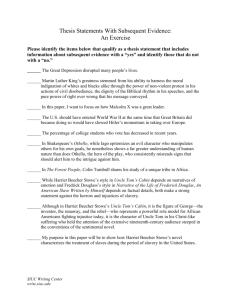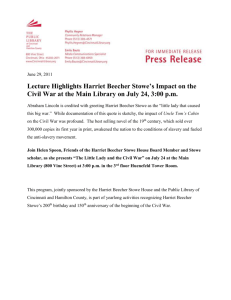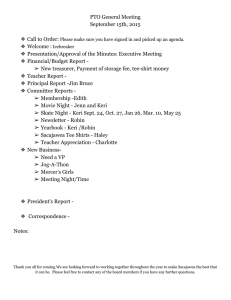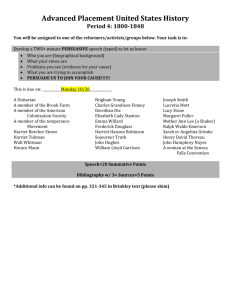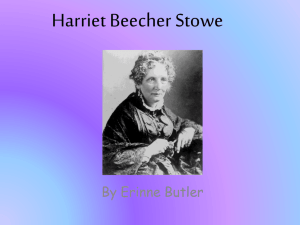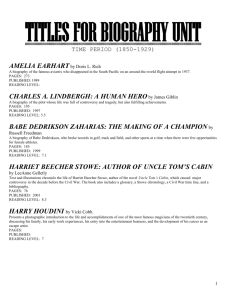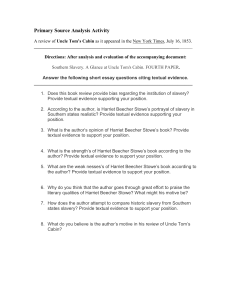Woman's History Month SOL Review - fchs
advertisement
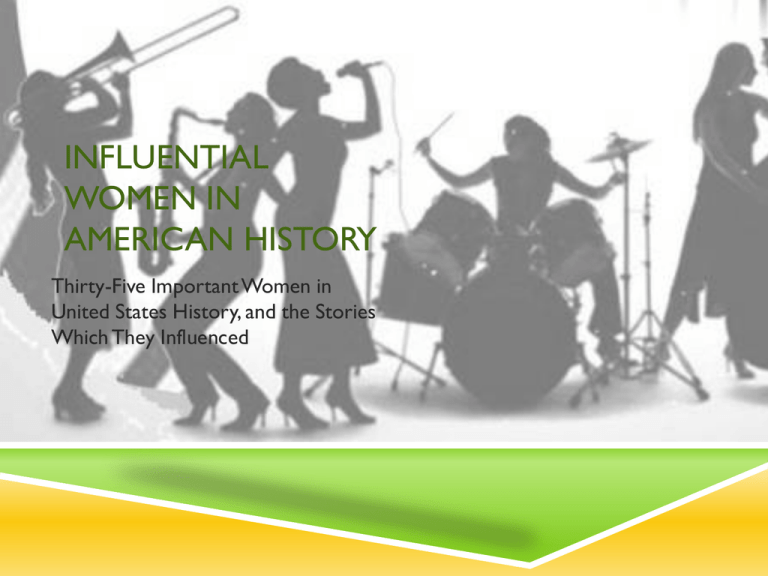
INFLUENTIAL WOMEN IN AMERICAN HISTORY Thirty-Five Important Women in United States History, and the Stories Which They Influenced SACAJAWEA Historians know very little about Sacajawea, but what we do know is fascinating. She was the teenaged wife of a French fur trader, Toussaint Charbonneau, and the mother of his child. The Corps of Discovery met Sacajawea in the winter of 1804 – 1805 at Mandan, when she lived with the Sioux tribe there. But originally, she was a Shoshone. When the Corps of Discovery went west, Toussaint Charbonneau, Sacajawea, and her infant son all joined the group. Only Sacajawea knew where they were going. So, at a crucial moment on the Lewis and Clark adventure, they were led by a teenage girl – with an infant son! ELIZABETH CADY STANTON Along with Lucretia Mott, Elizabeth Cady Stanton planned out the famed Seneca Falls Convention of 1848. At this meeting, she helped to author the Declaration of Sentiments, a document in which the women of the Seneca Falls Convention demanded the right to vote. Based on the Declaration of Independence, this statement demanded equality for women. HARRIET BEECHER STOWE During the Civil War, Abraham Lincoln is reported to have greeted Harriet Beecher Stowe with the line, “So, you’re the little lady that started this great war!” Why? Because Harriet Beecher Stowe was the author of the novel Uncle Tom’s Cabin, a divisive novel which brought the question of slavery to a head in the United States, and made abolitionism more mainstream than ever. HARRIET TUBMAN As the most accomplished “conductor” of the Underground Railroad, Harriet Tubman led dozens of enslaved men and women to freedom by following the North Star – the “Drinking Gourd” according to many African traditions – north of the MasonDixon line. Eventually, she needed to retreat as far as Canada. During the Civil War, she engaged in espionage. She also spoke out on behalf of women’s rights. IDA TARBELL Ida Tarbell was a muckraker – an investigative journalist who exposed problems in American society in the hopes that the government would help to bring reforms. Her most famous target was John D. Rockefeller’s Standard Oil Trust. She wrote the book, A History of the Standard Oil Company – describing all of the unfair business practice engaged in by Standard Oil. After her book’s publication, William Howard Taft would bring suit against Standard Oil for violating the Sherman Anti-Trust Act. In 1911, the company was broken up. JANE ADDAMS During the era of immigration, many thousands of immigrant families struggled to make the transition to prosperity in a new and unforgiving nation. Jane Addams founded the settlement house Hull House in Chicago, IL in order to help immigrants along during this period. The settlement house offered language classes, job skill training, and child care, as well as helping families satisfy their basic needs. QUEEN LILIUOKALANI In 1893, an American-led coup took over the Hawaiian islands, which were ruled at the time by Queen Liliuokalani. After her ouster by a combination of American businessmen and US Marines, she registered a formal complaint with the US Senate. In1893, a provisional government of Americans in Hawaii asked to be annexed by the United States. President Grover Cleveland refused to take over the islands, because the new government was illegitimate. In 1898, however, President McKinley annexed Hawaii, over the objects of the islands final monarch. SUSAN B. ANTHONY Perhaps the most important figure in the woman’s suffrage movement was Susan B. Anthony. Arrested for casting a ballot in her home state of New York in 1872 she never paid the fine. She advocated for equal rights for women throughout her life, founding both the American Equal Rights Association and the National Woman’s Suffrage Association. CARRY NATION & THE WCTU CARRY NATION & THE WCTU The Woman’s Christian Temperance Union was devoted to ridding the United States of “demon rum” and all other alcoholic beverages. Carry Nation, a six-foot tall, hatching-wielding prohibitionist zealot, was their finest soldier. Nation was known for rushing into bars with hatchet in hand, and smashing the bottles of alcohol in view – often while singing Christian hymns. FLAPPERS – CHANGES IN GENDER ROLES IN THE ROARING 1920S In the 1920s, women devoted to changing the standard gender roles of the nation were known as “flappers.” These uncommonly independent women were well known for consuming alcohol, smoking, bobbing their hair, and dressing in the most provocative style in American history. The clothe hat was just one feature. Dresses which exposed the elbows, and – gasp – the miniskirt – also turned heads. ELEANOR ROOSEVELT The wife of President Franklin Delano Roosevelt and the First Lady of the United States during both the Great Depression and the Second World War, Eleanor Roosevelt was a leading voice among women. She often sought out the poor – particularly poor African-Americans in the South to give their concerns a voice. She wrote weekly columns as First Lady, and also held press conferences exclusively for female reporters. After FDR passed away in 1945, Eleanor remained a major voice in the Democratic Party and served as an ambassador to the United Nations – formed after World War II as a peacemaking organization. FRANCES PERKINS Frances Perkins was appointed as the Secretary of Labor under Franklin Roosevelt, during the darkest hours of the Great Depression. She advocated for many New Deal programs which encouraged government hiring programs, and was a major proponent of the Social Security Act, which provided pensions for the elderly, the disabled, and the dependents of parents who could not provide. DOROTHEA LANGE Hired by the Works Progress Administration during the Great Depression to raise public knowledge of the desperate conditions of migrant families in the West, Dorothea Lange became the most famous photographer of her generation for her work during the Great Depression. The picture to the right, entitled “Migrant Mother,” touched an entire nation. ROSIE “THE RIVETER” During World War II, with over 15 Million men serving in the United States military, women were called upon to take on jobs which were not typically considered “lady-like.” When some women hesitated to take up riveting guns or work on assembly lines, the character “Rosie the Riveter” was created to celebrate the accomplishments of the millions of women whose efforts allowed the Allied Powers to win World War II. ROSA PARKS & JO ANN ROBINSON Everyone knows that Rosa Parks refused to give up her seat on a Montgomery Bus in December of 1955, sparking the Montgomery Bus Boycott where Rev. Dr. Martin Luther King became a modern Civil Rights hero. But did you know that Jo Ann Robinson organized the boycott? On the Friday before the boycott began, she printed off 35,000 handbills to be distributed at the local African-American churches that Sunday. She was a spiritual leader of the movement! DAISY BATES AND THE LITTLE ROCK 9 The Little Rock Nine were the nine students selected to integrate Little Rock, Arkansas’ Central High School in 1957. Those students had to escorted to school by the 101st Airborne division and were followed from class to class by soldiers on a daily basis. The woman who they leaned on for support the hardest was Daisy Bates, a leader of the Little Rock NAACP. ELLA BAKER AND THE SIT-INS OF 1960 Ella Baker frequently stated, “Strong people don’t need strong leaders.” So, she didn’t take credit for the actions which she helped to lead. In 1960, she was inspired by a group of students, the Greensboro Four, who led a sit-in protest at a lunch counter in that city. When students on college campuses across the South began to emulate these men, Ella Baker helped them to organize into the Student Non-Violent Coordinating Committee (SNCC). DOLORES HUERTA Dolores Huerta was the leader of a union for migrant workers in California who served as a cofounder – with Cesar Chavez – of the United Farm Workers Union. The union worked in order to improve pay, reduce working hours, improved housing conditions, and provide access to education for the children of the mostly MexicanAmerican farm workers who picked lettuce, grapes, and dozens of other crops in California. BETTY FRIEDAN Betty Friedan was the author of a book called The Feminine Mystique. She articulated a viewpoint during the 1950s and 1960s which attempted to explain why women – even the most successful women in society – continued to feel discontent. Friedan was a strong supporter of the Civil Rights Act of 1964 – which forbid discrimination against women and created the Equal Employment Opportunity Commission (EEOC). She also was the founder of the National Organization for Women (NOW). She was a leading spokesperson for women for decades and a supporter of the Equal Rights Amendment. EQUAL RIGHTS AMENDMENT It was proposed during the late 1960s and passed by Congress in 1972, but never ratified by the states. This is what the Equal Rights Amendment would have added to the Constitution, had it been ratified: Section 1. Equality of rights under the law shall not be denied or abridged by the United States or by any State on account of sex. Section 2. The Congress shall have the power to enforce, by appropriate legislation, the provisions of this article. Section 3. This amendment shall take effect two years after the date of ratification. ROE V.WADE (1973) Roe V. Wade was the 1973 Supreme Court decision which legalized abortion in the United States of America. The Supreme Court ruled that a woman’s right to an abortion was allowed by an implicit “right to privacy” guaranteed in the 14th Amendment to the Constitution. States must balance their laws, considering both the life of the mother and the life of an unborn child. Hence, states were entitled to forbid abortions in the final trimester of a pregnancy in certain circumstances, especially if the life of the unborn child was viable outside of the womb. GEORGIA O’KEEFFE Georgia O’Keeffe was one of America’s most unique and accomplished artists of the 20th Century. A leader of the Taos Movement, she was famous for works which focused on the juxtaposition of life and death, focused on symmetry, and often involved desert scenes (Taos is in the deserts of New Mexico.) RACHEL CARSON Rachel Carson is often called the founder of the modern environmentalist movement, largely because of her classic book Silent Spring. The book chronicled the damage being done to the environment by industrialized nations – including damage to the air, the water, and ecosystems which could cause irreversible damage and threaten the future of mankind. SANDRA DAY O’CONNOR Appointed by President Ronald Reagan in 1981, Sandra Day O’Connor was the first woman ever appointed to the Supreme Court of the United States. She served for twenty five years, from 1981 until her retirement from the bench in 2006. She was replaced by Samuel Alito. O’Connor was considered a moderate and was the swing vote in many cases towards the end of her career. She was undoubtedly one of the most powerful women in America during her career. RUTH BADER-GINSBURG, ELENA KAGAN, AND SONIA SOTOMAYOR The Supreme Court of the United States has changed dramatically since the early 1980s, with the addition of female justices. Ruth Bader-Ginsburg, Elena Kagan, and Sonia Sotomayor form the liberal wing of the Court today, and have consistently interpreted the 14th Amendment to the Constitution, for example, as a vehicle for the expansion of rights to women and minority groups. Presently, the relative balance of the Supreme Court is at stake, as the President and Congress find themselves in a standoff over the replacement for the late Justice Antonin Scalia. SEC. OF STATE CONDOLEEZZA RICE Under George W. Bush, Condoleezza Rice was the nation’s Secretary of State. Hawkish in her temperament, Rice encouraged a vigorous policy of military intervention in both Afghanistan and Iraq. Rice remains one of the nation’s most influential foreign policy experts, and she is one of the most popular conservative political figures in America today. In the aftermath of her service as Secretary of State, Rice has become a lead figure in the NCAA’s Bowl Championship Series in Division I College Football. Many expect her to seek political office on the national level in the coming years – and many believe she may be a sought after running mate in 2016. GOVERNOR NIKKI HALEY OF SOUTH CAROLINA Governor Nikki Haley of South Carolina was the first Indian-American woman elected to that office in American History. Haley’s rise to political fame and power in a state which has a long history of racially divisive politics was a surprise to many; however, she remains an exceedingly popular figure in the states Republican Party. In the summer of 2015, after a horrifying mass shooting at Mother Emmanuel AME Church in Charleston, SC, Haley led a movement to remove the Confederate flag from memorials in the state capital building in Columbia. This year, Haley was selected to deliver the response to the President’s State of the Union address. Her rising political star has many pundits talking about her as a potential running mate in the 2016 Presidential Election. She endorsed and campaigned with Senator Marco Rubio during the course of the primary campaigns. SARAH PALIN – TEA PARTY LEADER Sarah Palin was a little known and controversial Governor of Alaska before she was selected by John McCain as his Vice Presidential nominee in 2008. Since then, however, she has been a lightening rod for controversy – offering her political opinions on a variety of topics from gun control to health care to domestic oil production to foreign affairs. As one of the darlings of the Tea Party Movement, Palin’s endorsements are heartily sought after on the political campaign. Her most recent endorsement: Donald J. Trump. Although she came to prominence as the First Lady of the United States during Bill Clinton’s Presidency, she has proven to be a formidable politician and activist in her own right. She headed a committee to reform Health Care in the 1990s which made little to no progress. After Bill Clinton left office, she ran for the US Senate and represented the state of New York for six years. In 2008, she ran against Barack Obama for the Democratic nomination for President and came up just short. She served as Secretary of State under Obama, however, and is widely considered to be the frontrunner for the Presidential nomination of the Democratic Party in 2016. HILLARY CLINTON ALICIA GARZA, PATRISSE CULLORS, AND OPAL TOMETI – BLACK LIVES MATTER The Black Lives Matter Movement was founded initially in response to the killing of Florida teenager Trayvon Martin. In response to a series of killings of unarmed African-American men by police officers, the group grew dramatically in both its membership and its goals. “Black Lives Matter is a unique contribution that goes beyond extrajudicial killings of Black people by police and vigilantes. It goes beyond the narrow nationalism that can be prevalent within some Black communities, which merely call on Black people to love Black, live Black and buy Black, keeping straight cis Black men in the front of the movement while our sisters, queer and trans and disabled folk take up roles in the background or not at all. Black Lives Matter affirms the lives of Black queer and trans folks, disabled folks, Blackundocumented folks, folks with records, women and all Black lives along the gender spectrum. It centers those that have been marginalized within Black liberation movements. It is a tactic to (re)build the Black liberation movement.”
